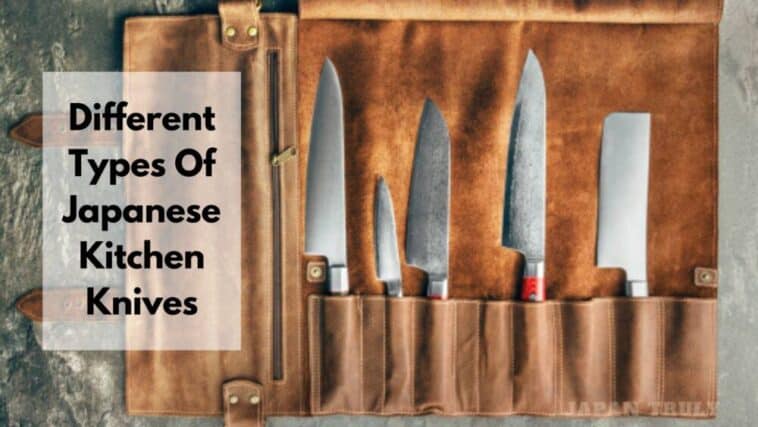Do you know there are 10 different types of Japanese kitchen knives in the Japanese kitchen? Let’s check them out!
Japanese cuisine is renowned for its emphasis on precision, aesthetics, and delicate flavors. A crucial aspect of achieving such culinary finesse lies in the use of specialized knives.
Japanese knives are distinct, boasting features like single-bevel blades, high-carbon steel, and a wide array of designs tailored for specific tasks.
In this article, we will explore various types of Japanese knives, each crafted with a unique purpose, and delve into the factors to consider when choosing the right knife for your culinary endeavors.
Page Contents
Types Of Japanese Kitchen Knives
Gyuto: The Japanese Chef’s Knife

The Gyuto, often referred to as the Japanese chef’s knife, is a versatile workhorse in the kitchen. Its features include a double-bevel blade, usually around 8 to 12 inches long, making it suitable for a variety of tasks such as slicing, dicing, and chopping.
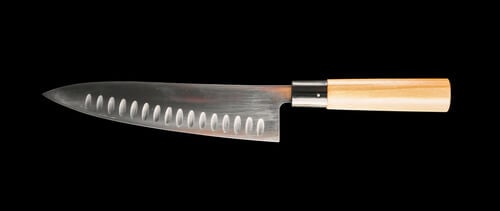
The Gyuto’s design blends Western and Japanese knife styles, catering to the needs of chefs who appreciate the precision of Japanese knives but are familiar with the Western grip.
Santoku: The All-Rounder
The Santoku, meaning “three virtues” in Japanese, is an all-purpose knife that excels in slicing, dicing, and chopping.
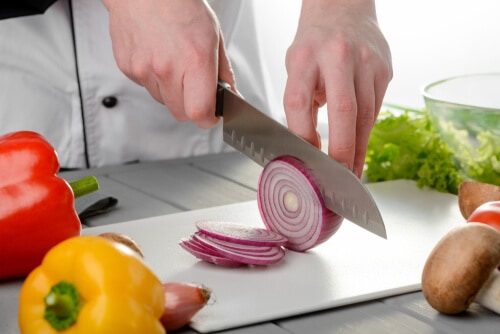
With a shorter and wider blade compared to the Gyuto, the Santoku is versatile and well-suited for various tasks.
It typically ranges from 5 to 7 inches in length, making it a favorite among home cooks for its manageable size and adaptability.
Nakiri: The Vegetable Knife
The Nakiri, specifically designed for chopping and slicing vegetables, features a unique rectangular blade.
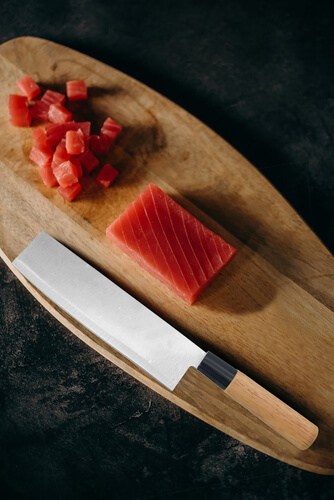
Its straight edge and thin profile make it perfect for precise vegetable cuts without causing bruising.
The Nakiri is a staple in Japanese kitchens, emphasizing the importance of precision in vegetable preparation.
Yanagiba: The Sashimi Knife
The Yanagiba, with its long, thin blade and single-bevel design, is the go-to knife for slicing sashimi with utmost precision.
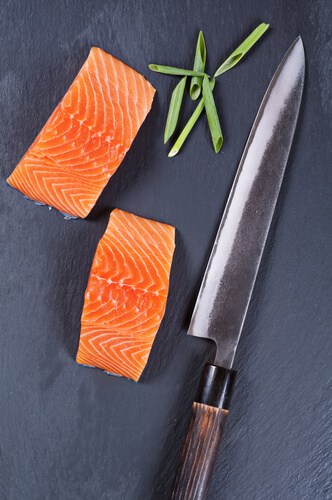
Its sharp edge enables clean cuts, ensuring the delicate texture of raw fish is preserved. The Yanagiba’s design reflects Japanese culinary values, emphasizing the artistry of food presentation.
Usuba: The Single-Bevel Vegetable Knife
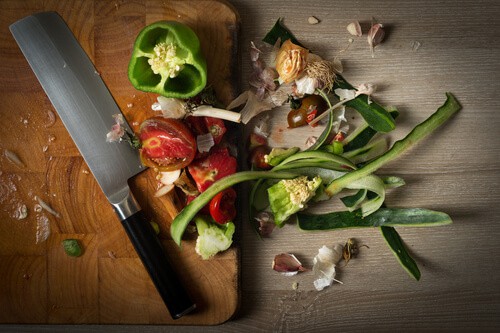
The Usuba is a single-bevel knife, known for its extreme sharpness and delicate cuts. Primarily used for vegetables, the Usuba’s thin blade allows for intricate and precise slicing, making it a favorite among chefs who demand perfection in vegetable preparation.
Deba: The Butcher Knife
The Deba, a heavy-duty butcher knife, comes in various variations tailored for different fish and shellfish. Its thick spine and sturdy construction make it ideal for tasks like filleting fish and breaking down shellfish.
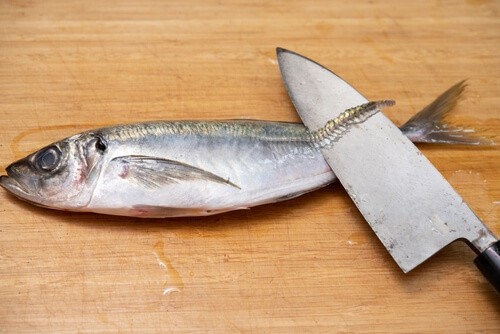
The Deba showcases Japanese knife craftsmanship in meeting the specific needs of different culinary traditions.
Petty: The Paring Knife
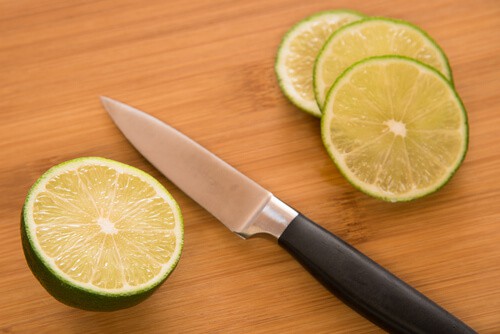
The Petty knife is a small, nimble blade designed for intricate tasks such as peeling, trimming, and creating fine garnishes. Its size and maneuverability make it a favorite among chefs for precise work that requires attention to detail.
Kiritsuke: The Versatile Knife
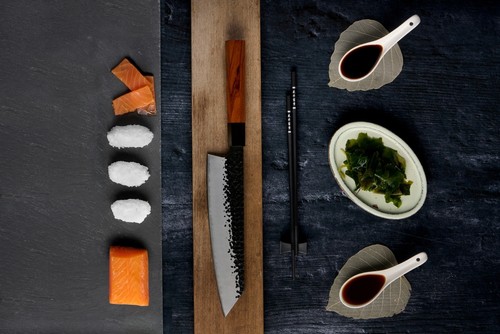
The Kiritsuke is a versatile knife featuring a unique angled tip, combining the functionalities of both slicing and chopping knives.
Traditionally, it was reserved for executive chefs, but now it has become more accessible, offering a hybrid design that appeals to those seeking versatility in a single knife.
Sujihiki: The Double-Bevel Sashimi Knife
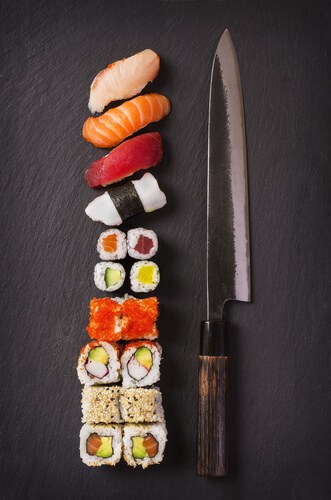
The Sujihiki, akin to the Yanagiba, is a double-bevel knife designed for slicing raw or cooked meats with precision.
Its thinner profile allows for smoother slicing, making it an excellent choice for those who appreciate the accuracy of Japanese knives but prefer a double-bevel design.
Mukimono: The Carving Knife
The Mukimono, a carving knife with a delicate blade, is designed for creating decorative cuts on vegetables. Its precision and sharpness make it an essential tool for chefs who want to add artistic flair to their culinary creations.
Honesuki: The Boning Knife
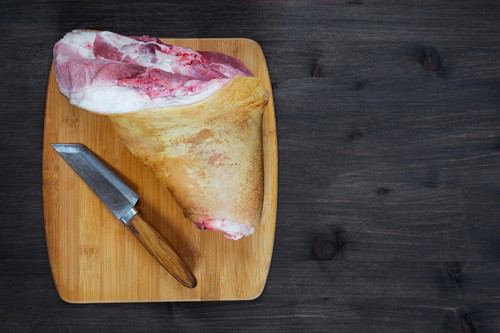
The Honesuki, a boning knife with a curved blade, is specialized for removing bones from meat. Its design ensures efficient boning while maintaining control, making it an indispensable tool in Japanese kitchens for butchering tasks.
Pankiri: The Bread Knife
The Pankiri, equipped with a serrated blade, is designed for effortlessly cutting through crusty bread without squashing it.
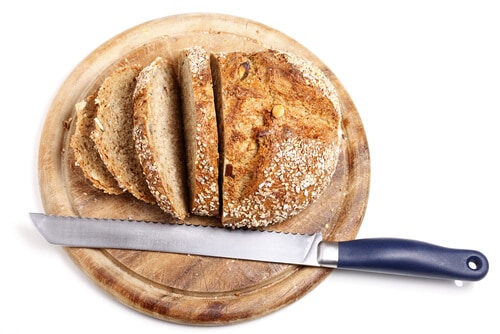
While not exclusive to Japanese cuisine, its inclusion in the repertoire of Japanese knives showcases the adaptability of these tools to various culinary needs.
Choosing the Right Japanese Knife
Selecting the right Japanese knife involves considering factors such as the type of cuisine you specialize in, your preferred cooking style, budget constraints, and maintenance requirements.
For beginners, a versatile option like the Santoku or Gyuto may be ideal. Intermediate and advanced cooks may explore more specialized knives based on their evolving culinary skills and preferences.
Caring for Japanese knives is crucial for maintaining their sharpness and longevity. Regular sharpening using whetstone or honing rods, proper cleaning, and safe storage are essential practices.
Investing time in learning proper knife skills also contributes to extending the life of these precision tools.
Conclusion
In the world of Japanese kitchen knives, diversity meets functionality, offering chefs an array of specialized tools for culinary mastery.
Whether you are a home cook or a professional chef, the right Japanese knife can elevate your cooking experience.
Embrace the precision, craftsmanship, and artistry inherent in these knives, and discover the joy of cooking with tools designed to bring out the best in your culinary creations.
Explore the world of Japanese knives, and let your kitchen be a canvas for precision and perfection.
My writing focuses on the various aspects of Japanese lifestyle, from traditional tea ceremonies and flower arrangement to modern fashion trends and pop culture. Through my articles, I aim to share my passion for Japan and provide readers with a glimpse into the rich and diverse world of Japanese culture.
I believe that the key to understanding Japanese lifestyle is to appreciate the balance between tradition and innovation. While Japan has a rich cultural heritage that dates back centuries, it is also a country that is constantly evolving and embracing new ideas and technologies.
Whether you’re interested in learning about the latest fashion trends in Tokyo, or want to explore the ancient art of calligraphy, my writing will take you on a journey through the many facets of Japanese lifestyle. So join me as we explore the beauty and complexity of this fascinating culture together!


